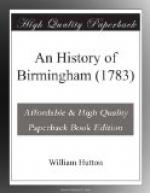Other church-yards are ornamented with the front of the buildings, but that of St. Martin submits to the rear.
The present church is of stone; the first upon the premises; and perhaps the oldest building in these parts.
As the country does not produce stone of a lasting texture, and as the rough blasts of 900 years, had made inroads upon the fabric, it was thought necessary, in 1690, to case both church and steeple with brick, except the spire, which is an elegant one. The bricks and the workmanship are excellent.
Though the fabric is not void of beauty, yet being closely surrounded with houses, which destroy the medium of view, that beauty is totally hid.
The steeple has, within memory, been three times injured by lightning. Forty feet of the spire, in a decayed state, was taken down and rebuilt in 1781, with stone from Attleborough, near Nuneaton; and strengthened by a spindle of iron, running up its centre 105 feet long, secured to the side walls every ten feet, by braces—the expence, 165_l_. 16s.
Inclosed is a ring of twelve musical bells, and though I am not master of the bob major and tripple-grandfire, yet am well informed, the ringers are masters of the bell-rope: but to excel in Birmingham is not new.
The seats in the church would disgrace a meaner parish than that of Birmingham; one should be tempted to think, they are the first ever erected upon the spot, without taste or order: the timber is become hard with age, and to the honour of the inhabitants, bright with use. Each sitting is a private freehold, and is farther disgraced, like the coffin of a pauper, with the paltry initials of the owner’s name. These divine abodes are secured with the coarse padlocks of a field gate.
By an attentive survey of the seats, we plainly discover the increasing population of Birmingham. When the church was erected, there was doubtless sufficient room for the inhabitants, and it was probably the only place for public worship during 800 years: as the town increased, gallery after gallery was erected, ’till no conveniency was found for more. Invention was afterwards exerted to augment the number of sittings; every recess capable only of admitting the body of an infant, was converted into a seat, which indicates, the continual increase of people, and, that a spirit of devotion was prevalent among them.
The floor of the church is greatly injured by internment, as is also the light, by the near approach of the buildings, notwithstanding, in 1733, the middle roof of the chancel was taken off, and the side walls raised about nine feet, to admit a double range of windows.
Dugdale, who wrote in 1640, gives us twenty-two drawings of the arms, in the windows, of those gentry who had connection with Birmingham.




